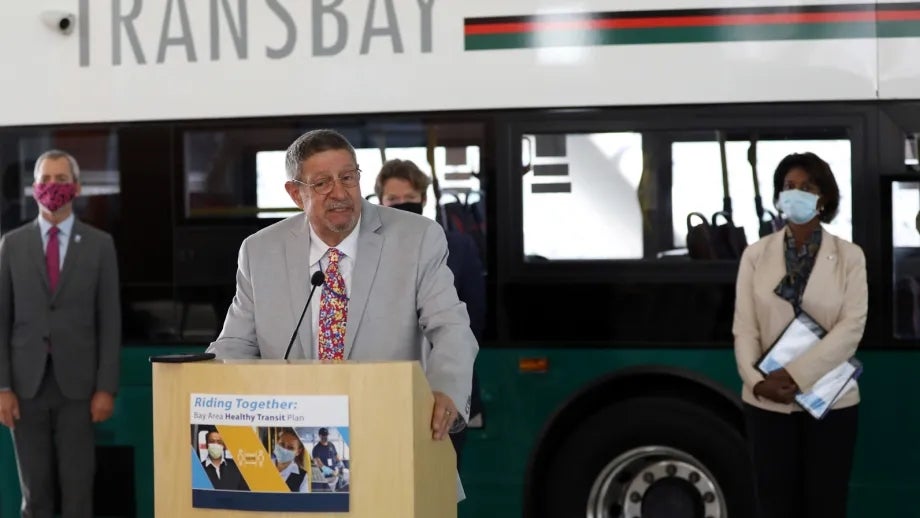Agencies Team Up to Roll Out Plan for Safe and Healthy Transit Operations
At a San Francisco event emceed by MTC Commissioner and Solano County Supervisor Jim Spering, Bay Area transit agencies today released the Riding Together: Bay Area Healthy Transit Plan to protect the health and safety of transit riders and employees, and to build confidence in public transit when the region emerges from shelter-in-place restrictions caused by the COVID-19 pandemic. The transit agencies jointly developed the plan to standardize their health and safety commitments as well as their expectations for employees and customers alike. These commitments are based on information from the California Department of Public Health, U.S. Centers for Disease Control and Prevention, and the World Health Organization; and Bay Area transit agencies drew on best practices from transit operators around the globe for the implementation of mitigation steps
Health and safety action items to protect riders include:
- Face coverings: Remind riders that masks are required, and transit providers have the right to refuse anyone without a face covering. Some transit operators will provide face coverings as capabilities allow;
- Physical distancing: Communicate the importance of social distancing to riders and manage capacity to achieve the three-feet social distancing minimum requirement with face coverings;
- Hand hygiene: Provide information to customers about the availability of hand-washing stations or hand sanitizer dispensers;
- Quiet ride: Launch the “Quiet Ride” campaign to ask riders to minimize talking, singing, laughing, etc., that might contribute to the spread of COVID-19;
- Cleaning and disinfecting: Clean and disinfect in-service vehicles daily with an emphasis on high touch areas. Use EPA- “List N” disinfectants with an elevated focus on vehicles that may have carried an infected rider;
- Ventilation: Maximize fresh air on vehicles and facilities based on ventilation options. Confirm maintenance on ventilation equipment and ensure systems offer peak performance;
- Touchless fares: Public outreach to encourage use of Clipper card for fare payments; and
- Paratransit: A greater focus on cleaning and disinfecting surfaces in paratransit vehicles as riders with disabilities may be especially vulnerable, and also more likely to be exempt from the face-covering requirement.
Keeping transit employees safe also is critical for the successful operation of the Bay Area’s transit network. The plan includes standards for agencies to protect their workers:
- Wellness Assessment: Develop and implement a COVID-19 assessment protocol for employees prior to accessing transit facilities or vehicles;
- PPE: Supply workers with Personal Protective Equipment including face masks (unless exempt). Perform job hazard analysis to identify potential exposure possibilities;
- Physical distancing: Determine common space capacities, stagger work hours, encourage eating outside and other social distancing tactics;
- Testing: Workers deemed essential have been given priority testing. Encourage workers to stay home if they feel sick; and
- COVID-positive employees: Record which employees are in facilities at any time and notify workers if they’ve possibly been exposed to someone who tested positive for the virus.
The Riding Together: Bay Area Healthy Transit Plan emerged from the transit agencies' work with the Blue Ribbon Transit Recovery Task Force organized by MTC in the spring of 2020. Several transit agency leaders who also serve as Task Force members provided comment on their efforts to combat the COVID-19 pandemic:
“BART and its transit partners are fighting this pandemic on every front. Our trains, stations, and employees are ready to welcome back riders with reliable and safe service and to win back the confidence of the tens of thousands of people who relied on BART before the pandemic.” Bob Powers, BART General Manager
“AC Transit’s renewal of service plan is developed on a foundation that protects the health and viability of our essential transit service,” said Michael Hursh, AC Transit General Manager. “It’s an onboard safety plan so robust, we can nimbly apply the identical frontline employee protocols to our passengers, so that each may seamlessly manage their return to work, school, and other life-sustaining services on transit.”
“During these difficult times, our agencies have rolled up our sleeves and met extraordinary challenges with great creativity and dedication,” said VTA General Manager/CEO and APTA Chair Nuria Fernandez. “We have doubled down on measures that protect the safety and health of transit employees and transit riders and are working extremely hard to show customers that we are safe, clean and consistent in our mission to provide mobility solutions for everyone.”
“Economic recovery can't happen without transit. And transit doesn't work if our passengers and operators don't feel safe,” said SFMTA Director of Transportation Jeffrey Tumlin. “The SFMTA’s Transportation Recovery Plan uses the latest international data and best practices to support San Francisco’s economic recovery by providing more essential trips, protecting the health and safety of our employees and customers, and serving those who are most dependent on transit.”
“Golden Gate Transit and Ferry are committed to keeping the public and our employees safe through this pandemic,” said Denis Mulligan, General Manager of the Golden Gate Bridge, Highway & Transportation District. “Whether you travel by bus, boat, or train, this new health and safety plan means you can return to transit with confidence. We’re proud to be a part of this regional collaboration to get the Bay Area moving safely again.”
“It has never been more critical for our respective agencies to come together and collaborate with a common goal of preserving safe, reliable public transit for those who need it most,” said San Mateo County Transit District General Manager/CEO Jim Hartnett. “While COVID-19 presents much uncertainty, it remains a constant that the regional economy cannot sustainably rely solely on single-occupancy vehicles.”
MTC video journalist Mark Jones contributed much of the footage in the video released to coincide with the launch of the Riding Together: Bay Area Healthy Transit Plan.


Submit your comment
In order to receive a reply to your comment, please provide an email address.